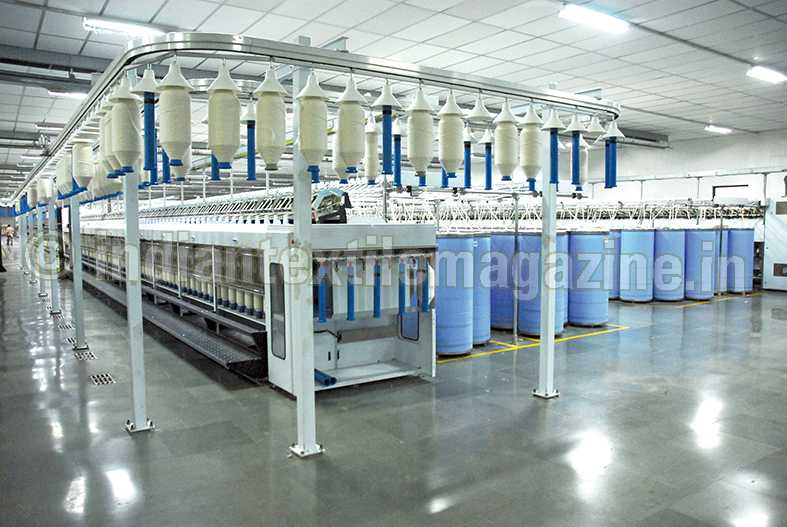– By Riju Jhunjhunwala, Jt. Managing Director, RSWM Ltd
Things are globally favourable for India’s textile industry. A few corrective measures from the Government may act as a catalyst for this vital sector.
The Indian textile industry is poised to recover its lost glory. It requires a few strategic inputs. The Indian sub-continent has all the ingredients covering the entire textile value chain, whether it is raw materials (natural or manmade); technological knowhow (machinery or product development/manufacturing); skilled manpower (abundant supply at competitive rates); locational advantage; domestic consumption (spread across the entire breadth of consumer market); market trendiness (latest fashion trends or brands), etc.
China is no longer the darling of the investors for textile manufacturing because of increasing input costs like raw material, labour and power. To counter this, there has been a strategic shift of the Chinese textile industry to move up the value chain by moving from commodity to fashion products, focus on domestic consumption more than exports, and develop local brands and new products in textiles. With cost advantages of textile manufacturing in China slowly going away, the investors are looking for alternate manufacturing locations. Though individual countries in the Indo-China region like Vietnam and SAARC countries like Bangladesh have managed to become huge textile bases in a short time riding on low cost labour, it still falls short of meeting the expectations of leading textile brands and retailers of having one-stop shop for sourcing of final product.
India can fit into this value chain by integrating itself along with its neighbours developing a symbiotic relationship. Let us look at each of the components of the textile value chain.
• Raw material: The country is one of the largest manufacturers of most of the natural fibers and man-made fibers. There is a need to ensure that adequate supply of quality fibers is available at sustainable prices. There is a need to ensure balance between retention of farmers interest in growing cotton and adequate availability of cotton to spinners at market prices.

The Government should gradually shift focus from minimum prices through budgetary support to increasing productivity on the same acreage by providing high yield seeds, usage of technology for crop management and reduced wastages in logistics and storage.
• Yarn spinning: The spinning mills in the country have seen growth in quantity and technology with huge capital investments aided under TUFS. Sufficient budget outlay towards TUFS will ensure timely disbursement resulting in increased project viability for spindles addition/upgradation. With the consumer demand shifting towards manmade fibers, the duty structure should be rationalized across all fibers to ensure parity with natural fibers.
• Fabric weaving: The fabric making industry is still reeling under low technology. The focus needs to be on rapid absorption of technology in the fabric weaving. This requires consolidation at the unit levels to ensure capital availability and fixed costs absorption on larger manufacturing base. The weaving centers across the country should be able to get raw materials locally at competitive rates; inputs on latest fashion trends and designs; access to state-of-the-art technology; trained manpower and; adequate supply of uninterruptible power at affordable prices.
• Dyeing/processing/printing: The average dyeing/processing/printing plants continue to be besieged with outdated technology resulting in high cost of production; low capabilities of matching desired colour/finish or reproduction of past colour/finish and; low adherence to safety and pollution norms. The available skillsets in this sector are limited and poor attempts have been made on the upgradation.
There is a need to modernize the sector with state-of-the-art technology, imported machinery and development of skillsets for product/process development and operations. Also there is a need to work with diverse range of chemicals and dyes, which are eco-friendly. The Government authorities needs to take the responsibility of development of support infrastructure for ensuring compliance to environmental standards as the costs can become exorbitantly high for individual or group of units.
• Garmenting: India has been losing competitive advantage of garmenting to Bangladesh and Vietnam, because of the increasing labour costs. There is a need to have balance with development of close business relationships with these countries and taking domestic proactive steps like: development of satellite towns around key cities like Delhi/Noida/Gurgaon and Bengaluru, where huge garmenting facilities can be developed with associated support infrastructure for transportation/boarding and lodging of manpower.
• Design and product/process development: Over a period of time, Indian fashion designers have groomed themselves into contemporary western wear and ethnic Indian wear. Some of them have been able to establish their names across the world and create high end design label.
Similarly a few companies have done pioneering work in development of products and processes in textiles. There is a need to encourage these designers and product/process developers through tangible and non-tangible support. With the growth in communication network, many of these can get worldwide recognition in very short duration.
Moreover there is a need to create platforms where collectively designers and manufacturers can come and showcase their products to prospective customers. This is possible at the level of Government bodies because of the multiplicity of stakeholders and complexity of relationships.
• Infrastructure development: The textiles industry is looking at geometric reduction in time and costs of deliveries. The reduction in lead time requires improvement in existing infrastructure like transportation, storage, etc., and the reduction in costing requires workings on water supply and treatment, quality, power availability, etc. The Government would do well to make available adequate infrastructure to the industry to take advantage of this opportunity.
The growth of the Indian textile industry will only help in socio-economic improvement as the textile sector in India ranks next only to agriculture in terms of not only job generation, and also accounts for over 20 per cent of the country’s industrial output and 30 per cent of foreign exchange earnings.
